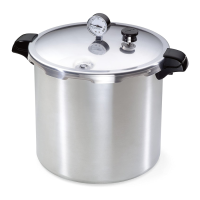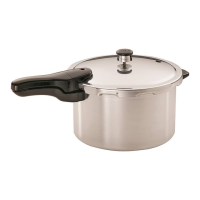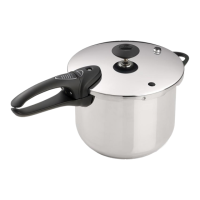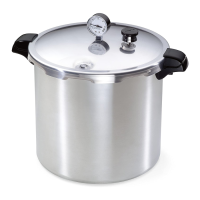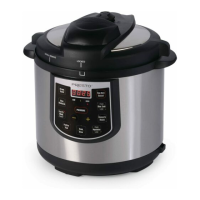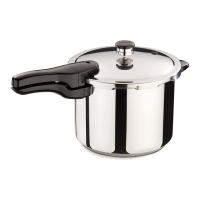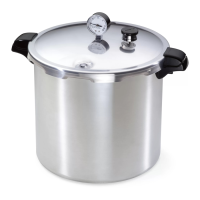20
PRESSURE CANNING SOUPS AND STOCKS
Pressure canning is the only safe method for canning soup and stock.
Soup or soup stock is quickly and easily canned. Soup should always be cooked ready for serving, then poured into hot jars, leaving
1-inch headspace. Generally, vegetable soups are more satisfactory if the stock and vegetables are canned separately and combined at
the time of serving.
CANNING RECIPES: SOUPS AND STOCKS
BEEF STOCK
Saw or crack fresh trimmed beef bones to enhance extraction of avor. Rinse bones.
Hot Pack: Place bones in a large pot and cover with water. Cover pot and simmer 3 to 4 hours. Remove bones. Cool broth; skim
off and discard fat. Remove bits of meat from bones and add to broth, if desired. Reheat broth to boiling. Fill hot jars
with hot broth, leaving 1-inch headspace. Remove air bubbles. Prepare jar rims. Adjust two-piece lids.
Process at 11 pounds pressure, pints 20 minutes and quarts 25 minutes. For processing above 2,000 feet altitude, see page 18 for recom-
mended pounds of pressure.
CHICKEN STOCK
Hot Pack: Place large carcass bones in a large pot; add enough water to cover bones. Cover pot and simmer 30 to 45 minutes or until
meat can be easily removed from bones. Remove bones. Cool broth; skim off and discard fat. Remove bits of meat from
bones and add to broth, if desired. Reheat broth to boiling. Fill hot jars with hot broth, leaving 1-inch headspace. Remove
air bubbles. Prepare jar rims. Adjust two-piece lids.
Process at 11 pounds pressure, pints 20 minutes and quarts 25 minutes. For processing above 2,000 feet altitude, see page 18 for recom-
mended pounds of pressure.
SOUPS
Vegetable, Dried Bean or Pea, Meat, Poultry, or Seafood
Choose your favorite vegetables, dried beans or peas, meat, poultry, or seafood ingredients for soup as long as those ingredients have
their own individual canning recommendations. Do not use ingredients for which there are no canning recommendations.
CAUTION! Do not add noodles or other pasta, rice, our, cream, milk, or other thickening agents to home canned soups as processing
time may not be adequate.
Hot Pack: Prepare vegetables, meat, poultry, and seafood as described in the hot pack directions for the individual ingredients. If
dried beans or peas are used, they must be fully rehydrated before adding to other ingredients (see page 29) Combine
solid ingredients with meat broth, tomatoes, or water to cover. Boil 5 minutes. Salt to taste, if desired. Fill jars halfway
with solid ingredients and then add soup liquid, leaving 1-inch headspace. Adjust two-piece lids.
Process at 11 pounds pressure, pints 60 minutes and quarts 75 minutes. If soup contains seafood, process pints and quarts 100 minutes.
For processing above 2,000 feet altitude, see page 18 for recommended pounds of pressure.
HOW TO CAN FOODS USING BOILING WATER METHOD
If using your canner on an induction or smooth-top range and using the boiling water method of canning for quart jars, consult with the
range/cooktop manufacturer for any weight restrictions. The lled canner weight is over 50 pounds.
1. Place cooking/canning rack on bottom of canner. Fill canner halfway with water.
2. Remove overpressure plug and pressure regulator from canner cover and set aside.
3. Preheat water to 140°F for raw-packed foods and to 180°F for hot-packed foods.
4. Use jar lifter to place lled jars, with lids and bands fastened according to manufacturer’s directions, on cooking/canning rack in canner.
5. Check water level. Add more boiling water, if needed, so the water level is at least 1 inch above jar tops.
6. Look through the vent pipe on the canner cover to be certain it is clear before placing cover on canner. To clean the vent pipe, draw
a pipe cleaner or small brush through the opening; see page 6.
7. Place cover on canner, aligning the V mark on the cover with the inverted V mark on the body handle. Lock securely by turning in the
direction indicated to close the cover (clockwise). Cover handles must be above body handles. Do not force beyond this position.
8. Turn heat on stove to its highest setting until water boils vigorously.
9. Set a timer for the minutes required for processing the food based on tested canning recipe.
10. Lower the heat setting to maintain a gentle boil throughout processing.

